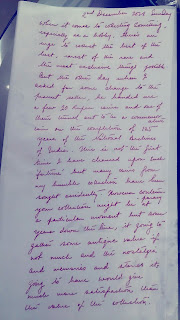The Coin Speaks - Pre Independence Regal Issues.
In my previous post about coins, I said about the 1/12th ANNA coin in which I took interest and tried to find out about the then monetary system.
After winning the Battle of Plassey (1757) followed by Buxar (1764) the British East India Company got a political hold over the Province of Bengal and from then till the Revolt of 1857 the Br E.I.C. ruled over a major part of the Indian Sub-Continent. With the Transfer of Power from the Br.E.I.C. to the British Crown, the monetary system underwent a change too. Though I am personally not aware of how commonly in use were the coins of the the E.I.C in everyday transaction, but the Regal Issues were certainly used.
Back in those days (mid 19th to early 20th Century) 1 Rupee had a significantly high value. Fractional system was in use and Indians were quite used to making calculations using the Fractional System. Fractional Method was introduced in the Monetary System by . Since then it had been widely used. The British continued this fractional currency system and introduced a new series of coins which are known as Regal Issues after 1857 upto 1947.
The best thing about this Fractional system is the use of Mathematics and the complex nature of it. 1 Rupee is divided into almost 256 parts. In today's context 1 Rupee is almost invalueable, but 100 years ago it was very valuable.
The RUPEE was divided into ANNAS which was divided into PAISE/PICE which was further divided into PIES.
The Calculation is as follows :
1 Rupee = 16 Annas or 64 Pice/Paise or 192 Pies or 256 Damadis.
1 Rupee = 16 Annas
1/2 Rupee = 8 Annas - Athanni/Dheli
1/4 Rupee = 4 Annas - Chawanni/Pavala
1/8 Rupee = 2 Annas - Dawanni/Beda
1/16 Rupee = 1 Anna - Ekanni
1/32 Rupee = 1/2 Anna -Athanni/Taka/Paraka
1/64 Rupee = 1/4 Anna = 1 Pice or 1 Paisa or Quarter Anna - Kani
1/128 Rupee = 1/8 Anna = 1/2 Pice/Paisa -Dhela
1/192 Rupee = 1/12 Anna = 1/3 Pice/Paisa - Pie/Pies
1/256 Rupee = 1/16 Anna = 1/4 Pice/Paisa - Damadi/Damari
The above calculation may seem complicated but if read carefully one can understand it.
1 Rupee is divided into 16 Annas or 64 Pice/Paise.
1 Anna is divided into 4 Pice/Paise
1 Pice or Paisa is divided into 3 and 4 parts, the 3rd being a Pie and the 4th being a Damadi.
Thus the Pie (1/12th Anna) and Damadi (1/16th Anna) are such miniscule amounts in today's context but back then they were a part of everyday transaction.
The Obverse of the coins had the face value, either in words or figures, with a border of floral-creeper pattern. The Reverse had the bust of the then ruling British monarch.
From 1862 to 1901 - Queen Victoria
From 1901 to 1910 - King Edward VII
From 1910 to 1936 - King George V
From 1937 to 1947 - King George VI
Such was the intricacy and complexity of coinage which needs to be appreciated. After Independence, Indian coinage underwent a reform and a new decimalized system came into use.
Stay tuned for the next article on Post Independence Coinage.
#commemoration #coins #coincollecting #coincollection #coincollector #coinpower #numismatic #numismatics #numismatica #numismaticahobby #coincollectionhobby #hobby #india #indiancoin #5rupees #worldofcoins #coinlover #coinlovers #coincollectorsofinstagram #coincollectors #worldcoins #worldcoinjewelry #worldcoinsnotes #coinworld #historygeeks #historylovers #history #preindependence #indian #incredibleindia #historyfreaks #legacy #legacies #memoirs #past #quarteranna #1938 #1/12anna #britishraj #britishrajcoins #britishindiacoins #indiancoins #oldcoins #vintagecoins #numismatica #numismatist #numismatic #numismatics #oldindiancoins #georgev #george5 #georgevi #george6 #kingemperor








Comments
Post a Comment